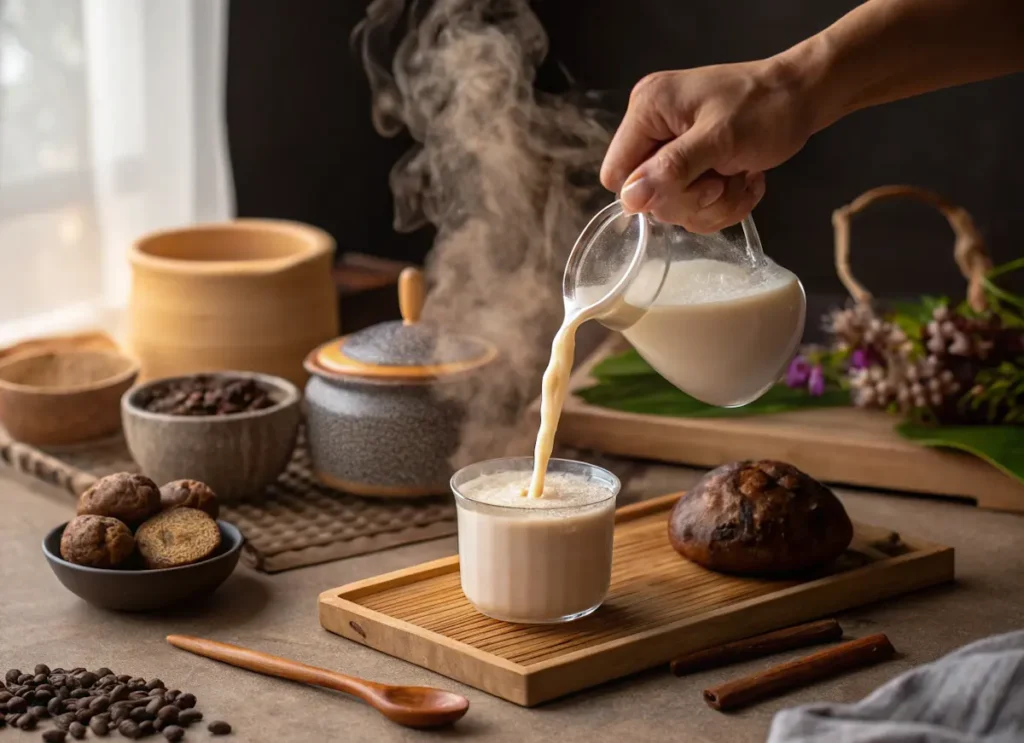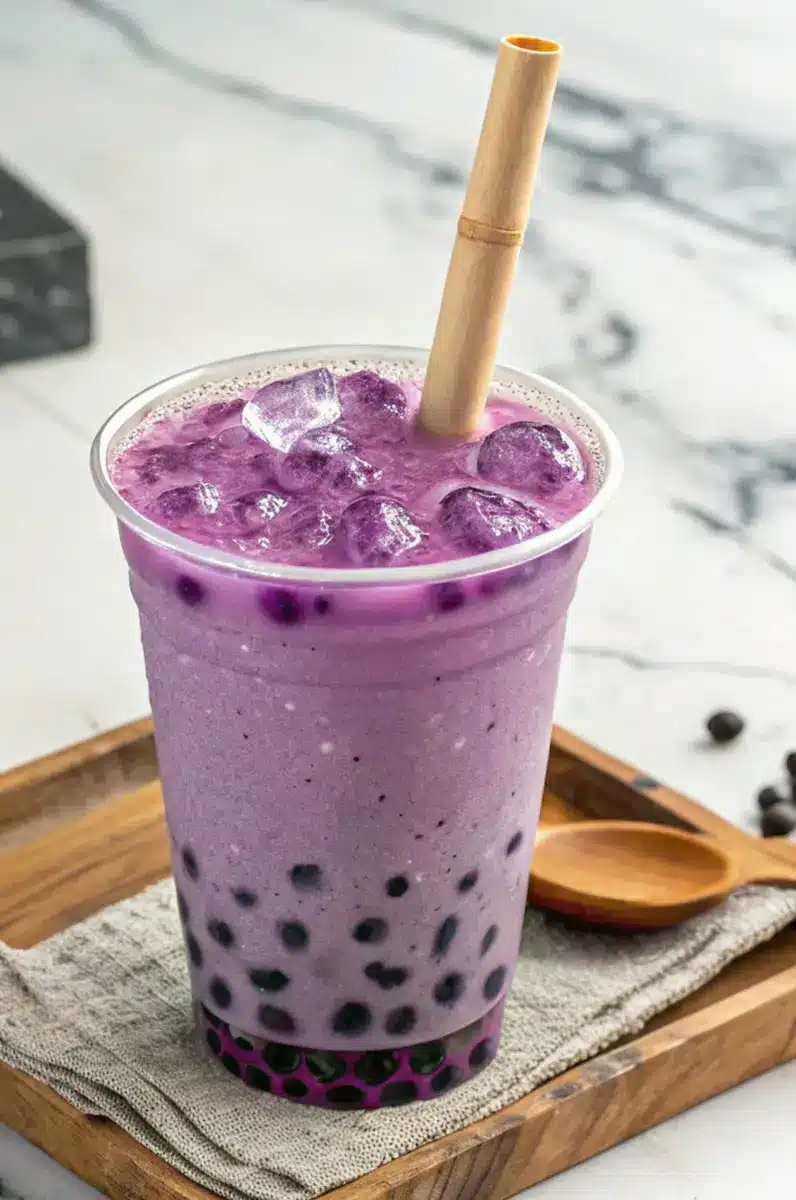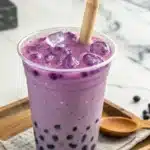What is taro milk tea? It’s more than just a vibrant purple drink—it’s a global sensation with deep cultural roots. I first discovered taro milk tea during my childhood in Southeast Asia, where colorful street drinks were part of daily life. One day, under the sweltering sun, I stopped by a stall and ordered a lavender-colored beverage filled with chewy pearls. I was instantly hooked.
That creamy, slightly nutty flavor transported me. Years later, taro milk tea still feels like home in a cup. This article will guide you through what makes it so special—from its root ingredient to its global popularity, taste, and homemade preparation.
Table of Contents
What is Taro Milk Tea? Your Guide to This Vibrant Purple Drink
Taro milk tea is a globally loved beverage made with sweet, nutty taro root, creamy milk, and optional chewy tapioca pearls. Its unique purple hue and velvety texture make it a comforting treat with deep cultural roots.
- Prep Time: 10 minutes
- Cook Time: 15 minutes
- Total Time: 25 minutes
- Yield: 2 servings 1x
- Category: Drink
- Method: Blended
- Cuisine: Asian Fusion
Ingredients
- 1 cup brewed black tea (optional)
- 2 tbsp taro powder or ½ cup cooked mashed taro
- ¾ cup milk (dairy or non-dairy)
- 1–2 tbsp sugar or condensed milk
- ½ cup cooked tapioca pearls (optional)
- Ice cubes
Instructions
- Brew black tea and let it cool slightly.
- Mix taro powder with hot water until smooth (or mash your cooked taro).
- In a shaker or blender, combine the tea, taro, milk, and sweetener.
- Shake well or blend until fully mixed.
- Pour into a glass with ice.
- Add boba pearls or jellies if desired.
Notes
For a healthier version, use fresh taro and reduce sugar. Taro milk tea can be made caffeine-free by omitting the tea base.
Nutrition
- Serving Size: 1 glass
- Calories: 220
- Sugar: 18g
- Sodium: 60mg
- Fat: 6g
- Saturated Fat: 3g
- Unsaturated Fat: 2g
- Trans Fat: 0g
- Carbohydrates: 38g
- Fiber: 1g
- Protein: 3g
- Cholesterol: 10mg
What Exactly is Taro? The Root Behind the Rich Flavor
Taro Root Explained
To understand what is taro milk tea, you first need to know about taro itself. Taro is a starchy root vegetable cultivated in Asia, Africa, and the Pacific Islands. It’s one of the oldest crops in the world, prized for its versatility in both savory and sweet dishes.
Raw taro has brown, hairy skin and white to light purple flesh. When cooked, it becomes soft and creamy. It’s a staple ingredient in everything from steamed buns to desserts across Asian cultures.
Its Appearance and Texture
Once cooked, taro’s pale flesh takes on a slightly purple hue. It has a texture similar to cooked potato—smooth, starchy, and satisfying. This makes it ideal for blending into milk tea for a rich, velvety mouthfeel. You’ll also see it used in drinks like ube milk tea or dishes featuring matcha green tea with coconut milk.
Its natural characteristics give taro milk tea its famous texture and flavor, elevating it from just a drink to a unique sensory experience.
Deconstructing Taro Milk Tea: Ingredients and Preparation
Taro
A defining feature in what is taro milk tea lies in how taro is prepared. Most cafes use taro powder, which is flavored and sometimes artificially colored to ensure that signature purple. However, traditional recipes use real taro root. Cooked and mashed, fresh taro delivers a more earthy, authentic taste.
Powder is convenient and consistent, but nothing beats the satisfaction of fresh taro paste blended into your drink. It gives a slightly grainy texture that enhances the creamy body of the milk tea.
Tea Base, Milk, Sweetener, Add-ins
Now let’s break down the rest of the ingredients:
- Tea Base: Black or green tea is typically used. Some variations skip the tea entirely to let the taro shine.
- Milk/Creamer: Dairy milk, coconut milk, or almond milk all work. Non-dairy creamer is often used in bubble tea shops for extra smoothness.
- Sweetener: Sugar, condensed milk, or honey is added to taste.
- Optional Add-ins: Tapioca pearls (boba), pudding, or jellies are popular. If you’re curious about boba, visit our guide on bubble milk tea calories or milk tea calorie facts.
To prepare, mix the taro (powder or mashed) with hot water, blend with tea and milk, add sweetener, shake or stir, and pour over ice. It’s quick and fully customizable. You can also explore other textures like strawberry milk tea boba for fun variations.
What Does Taro Milk Tea Taste Like? A Unique Sensory Experience
Sweet & Nutty
The most common way people answer “what is taro milk tea like in flavor?” is this: it’s naturally sweet, nutty, and comforting. The root has a subtle sweetness that blends perfectly with milk, giving the drink its smooth, satisfying profile.
It’s often compared to vanilla or roasted sweet potato. The sweetness isn’t overpowering—it’s mellow, letting the nuttiness and creaminess come through. That’s what makes it both indulgent and easy to drink.
Subtly Floral/Vanilla, Creamy Texture, Earthy Undertones
The taste goes even deeper. Many people detect hints of floral notes or vanilla, especially in versions using real taro. The drink is also incredibly creamy, thanks to the milk or creamer, and the starch from the taro itself.
There’s also a slight earthiness, reminding you that this drink comes from a root vegetable. And of course, there’s the iconic purple hue—an aesthetic feature often enhanced with food coloring. You’ll find similar depth of flavor in drinks like lavender milk tea or sakura rose milk tea.
The Global Phenomenon of Taro Milk Tea (And Bubble Tea in General)
Origins
Understanding “what is taro milk tea” also means knowing where it comes from. Bubble tea originated in Taiwan in the 1980s. The original versions were simple—just sweet milk tea and tapioca pearls.
Taro soon became a star flavor, admired for its color, mild sweetness, and texture. Its rise mirrors the global growth of bubble tea, which exploded across Asia and quickly reached North America, Europe, and beyond.
Rise to Popularity and Cultural Impact
Social media played a big role in spreading taro milk tea worldwide. Its purple color makes it instantly recognizable and highly shareable online.
Beyond visuals, taro milk tea also holds cultural meaning. For many, it evokes nostalgia and comfort. It bridges generations—appealing to both elders who recognize taro from traditional dishes, and younger drinkers looking for modern flavors.
Alongside drinks like genmaicha milk tea and earl grey tea milk, taro milk tea has become a symbol of Asian culinary creativity.

How to Make Taro Milk Tea at Home: A Simple Recipe
Ingredients List
- 1 cup brewed black tea (optional)
- 2 tbsp taro powder or ½ cup cooked mashed taro
- ¾ cup milk (dairy or non-dairy)
- 1–2 tbsp sugar or condensed milk
- ½ cup cooked tapioca pearls (optional)
- Ice cubes
Step-by-Step Instructions
- Brew black tea and let it cool slightly.
- Mix taro powder with hot water until smooth (or mash your cooked taro).
- In a shaker or blender, combine the tea, taro, milk, and sweetener.
- Shake well or blend until fully mixed.
- Pour into a glass with ice.
- Add boba pearls or jellies if desired.
Want to go further? Try a floral twist with rose tea milk or explore traditional options like okinawa milk tea. These recipes offer variety without losing that comfort in every sip.

FAQ: Your Top Questions About Taro Milk Tea Answered
Q1: Is taro milk tea healthy?
Taro root has fiber, vitamins, and minerals. But commercial versions often use sugary powders and creamers. Opt for fresh taro and less sugar at home to make a healthier drink.
Q2: Does taro milk tea contain caffeine?
If made with a tea base like black or green tea, yes. If not, it’s caffeine-free. Always check the recipe or label.
Q3: What is the purple color in taro milk tea?
Natural taro can be light purple, but most commercial versions use food coloring in the powder. Fresh taro yields a softer, more muted hue.
Q4: Can I make taro milk tea without dairy?
Definitely. Taro pairs well with coconut milk, almond milk, soy milk, or oat milk. Many cafes now offer fully dairy-free versions.
Conclusion: Embrace the Unique Flavor of Taro Milk Tea
Now that you truly understand what is taro milk tea, you’ll see why it’s more than just a drink—it’s a delicious link between tradition and modern tastes. Its creamy, sweet, and nutty profile makes it stand out, while its signature color gives it instant appeal.
Whether you try it from a bubble tea shop or craft your own at home, this purple delight is a must-experience. For more inspiration, don’t miss our full taro milk tea recipe or explore our entire drink recipes collection.


